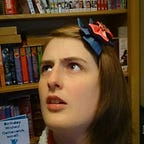Working with a Book Cover Illustrator
Working on a book is long stretches of being a lonely loner followed by a sudden realisation that, oh crap, now you have to work with actual, living people!
For the independent author there are a few choices when it comes to getting a book cover, including making something yourself in something like Canva. But if you can afford to save up the cash you can work with an illustrator or graphic designer.
I won’t go into the details of finding someone, partly because I already knew who I wanted and partly because that feels like a topic all of its own.
The relationship between a writer and artist is always going to be different. But I can talk through how it worked for us and what I did to try and make things easier for Rachel my cover artist. The first step was to just establish the kind of things I was a fan of. I sent Rachel a few of my favourite book covers, with the reasons why I liked them.
I love the minimalist approach of Jonathan Strange & Mr Norrell but at the same time I liked the detailed illustrations of the Cabal books. So that was something I knew would have to be resolved early in the process.
I didn’t have a clear idea of what I wanted the cover to be so I started thinking of a few things that could go on there. Demons were central to the book so I thought they could go on there. I’ve always loved the imagery of big bat-like wings and the main character fights lots of monstrous demons so they could go on too.
I asked for some variations of covers with the two main characters, surrounded by demons, possibly fighting them. The only problem was that these felt like storyboards for a film or a mid-story illustration rather than a representation of the whole story.
*Big spoiler for The Darwin Solution* One cover had Freya as the sole subject with her back facing you and her wings and horns in plain sight. I loved it but it was really important that Freya’s half demon nature wasn’t given away before the reader even started the book. *Spoiler over*
We stuck with the idea of the wings as I wanted something more abstract and symbolic of what was in the story rather than an interpretation of a specific character or scene. Rachel offered some suggestions and at this stage I was more than happy for her creative ideas to help guide us towards the right direction.
Other than “I like that idea” and “can we put a crow on there?” my input was fairly minimal at this point.It’s important to trust in your cover artist, if they think something will work better, give them the freedom to at least try it. If you’ve hired this person, it’s because you trust in their experience and know-how. I started out having very little idea with what I wanted the final product to be, but thanks to Rachel I had lots of great options to go with.
I know Rachel is a fan of drawing skulls and tentacles and seeing as there is a squid early in the story, I suggested she try putting some on there. But sadly it wasn’t to be. We’d thrown lots of things at the cover and it was starting to look crowded. We brought it right back to the essentials. My aim at this point was to have things that represented the main 4 characters. The key and sword for Freya, the book and medicine for Langdon, the electricity for Liz and the literal wolf (moved to the back) for Matt.
Once we reached the point of knowing the main design was in place, this was where I tried to be more specific in changes. It’s helpful to be clear about what changes you want making and avoid vague phrases like “can it be more exciting?” It’s far more helpful for them to be told “Can the font be a few sizes bigger? Can this be on the other side? Can the wolf ears be down, not up?”
To help the writer/ artist relationship it’s also a good idea to find out if they have any rules about drafts and edits. Do they have a limit on how many changes they make? Is there a chance of an extra charge for later edits? How long do they typically spend on a book cover? Knowing their rules and processes will make you more confident in what you’re asking.
It’s important that you’re happy with the final product but if an artist only allows so many re-dos it might make you think a bit more about what you want so you can make requests without wasting too much of their time. I was very lucky in this respect. Rachel got things to how I wanted very quickly and so the final few days was a matter of letting her work on the colours and final effects. And that was it! The next part was just a case of getting measurements and finalising a version for print.
Summary
- Find artist
- Initial ideas and sketchs
- Decide on prefered version
- Artist creates first design
- If happy, refine. If not, request larger changes.
- Refine and ask for specific, smaller changes
- Artist adds colour
- More refining (if needed)
- If happy, receive cover in desired formats.
If you want to hear about the process from the artist herself, check out Rachel’s blog. If you have any questions about working with a cover artist, please leave comment or come find me on Twitter!
Originally published at www.emzorzin3d.com.
